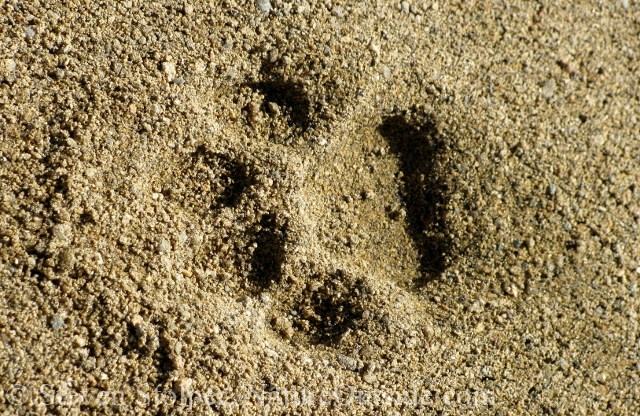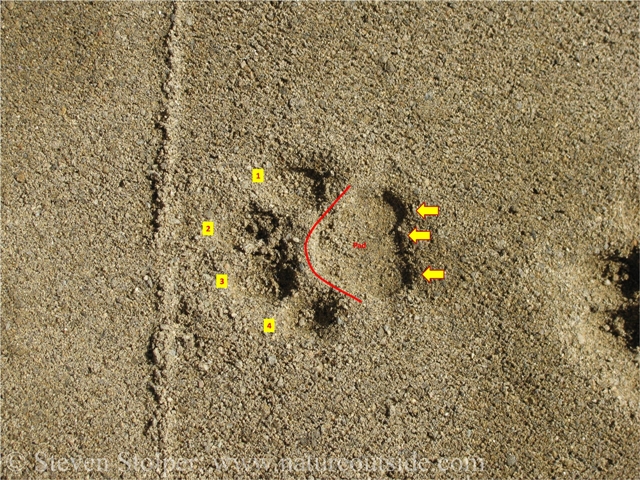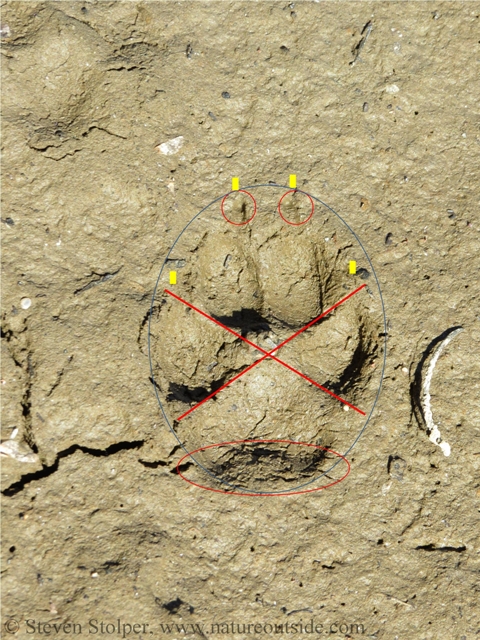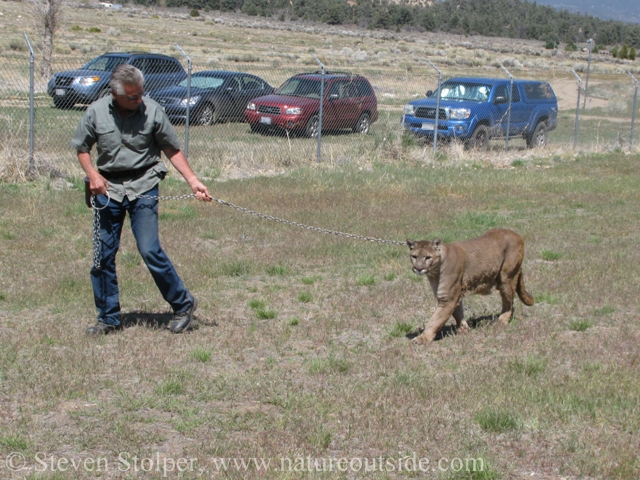
Finding a mountain lion track is an electric experience. While you may “know” there are big cats out there, seeing evidence in person is quite another matter. My first reaction is always excitement at finding the track. My second depends if I’m hiking alone. When hiking solo, I admit to a little apprehension. It is discomfiting to realize you are not the only large predator on the prowl that day.
But my unease is purely emotional. If you do a risk assessment, mountain lion attacks should be low on your list. Falls, hypothermia and getting lost pose much larger risks to the hiker than does an animal attack.
Instead we should enjoy our wonderful opportunity to get to know this wild creature. The following sections give you some tips for identifying mountain lion tracks. Later this week, I will post a short quiz so you can practice your skills.
Identifying Mountain Lion Tracks
If you are lucky enough to see one of these…

Mountain Lion Track – Picture has been annotated
… I hope you are inspired to learn more about the track. Let’s examine some of the questions I ask myself when I see a track like this. Note that the animal is walking from the right of the picture to the left.
How big is the track?
The size of the track is a clue to the identity of the animal that left it. Mountain lion tracks are very large. Most small carnivores like bobcats, fox, or coyote will leave significantly smaller tracks.
Front: 2.75 – 3.875 inches long X 2.875 – 4.875 inches wide1
Rear: 3.0-4.125 inches long X 2.56 – 4.875 inches wide1
By comparison, here are the dimensions for bobcats:
Front: 1.625 – 2.375 inches long X 1.375 – 2.5 inches wide1
Rear: 1.563-2.375 inches long X 1.188 – 2.5 inches wide1
You can see that bobcat tracks are quite a bit smaller than adult mountain lion tracks. I carry a small ruler in my tracker’s pack. The ruler is handy for measuring the length and width of individual tracks.
Is it a cat or a dog?
There are three characteristics I observe when trying to decide whether the track was left by a cat or a dog.
Seeing claw marks steers me toward a canine. Cats have retractable claws, which rarely show in most substrates. As always, there are exceptions. When seeking better traction, cats may use their claws. The grey fox has claws that can retract. But in general, seeing claw marks is often diagnostic of dog. I have circled the claw marks in the picture of the dog track below.
The overall shape of the track is also a clue. Dog tracks tend to be longer than wide (see oval in picture below). Cat tracks often seem wider than they are long. The negative space between the toes and the rear pad yields information. For cats, the position of the toes with respect to the heel pad lets you draw an arc between them (see arc in picture above). With dogs, you can draw an “X” between the front and side toes without impinging on the heel pad (see picture below).
The shape of the heel pad is also distinctive. The pad in the mountain lion track above is on the right and characterized by a three-lobed shape on the trailing edge (see arrows in picture above). It makes me conjure a mental picture of the letters “E” or “M”. Dogs have two lobes at the trailing edge of their pad (see red oval in picture below)
Below is an annotated picture of a dog track in the mud. I believe it may be coyote, but my notes from when the picture was taken indicate the presence of domestic dog tracks in the same area. Unfortunately, I discovered that I do not have a better picture of canine tracks.

Dog track – Picture has been annotated
If you are interested, I found a great article online that goes into more depth about the difference between cat and dog tracks: Canine vs. Feline
Is it a right or a left?
Mountain Lion tracks are asymmetrical. Their paws are arranged just like our hands! We can use this similarity to interpret whether a track is a left or a right. The trick is to look at the positions of the toes in relation to one another. There are two common ways to do this. I will discuss my favorite way first.
Method #1
Hold out your hands, palms downward, and fold your thumbs underneath. Look down at the tops of your hands. Imagine your fingers are the toes of a Mountain Lion. For most of us, our middle finger is the longest. Mountain lion paws are the same way. Their paws are asymmetrical with the “middle finger” being the toe that is farthest forward.
Looking at the picture at the top of this post, I find it helped to turn my head 90-degrees to the left. The most forward toe is the one labeled “2”. There are two toes on the outside of the track and one inside of it. So, it is a left.
Method #2
If you look at toes 4, 3, and 2 in the top photo, you can almost lay a straight edge across the tips of the toes. You can’t do that with toes 1, 2, and 3 without cutting off part of toe 2. The 3 toes that are almost in line are always on the outside of the foot. That makes the foot in the picture a left foot. It is a little difficult to see on this particular track, so you will have to try it yourself.
Is it a front or a rear?
Four-legged animals carry most of their weight on their front feet. So the front feet are often larger and broader than the rear ones. With mountain lions, the front claws are used to subdue prey. So the front feet should make noticeably larger tracks than the rear ones.
Is it standing right behind me?
Just kidding! 😀
Beware Generalizations
The size and shape information I provided above can vary greatly depending on:
- Terrain
- The substrate the animal is traveling through
- Its gait
- Individual differences
- Age of the animal
Individual differences pose the greatest challenge for beginning trackers. We intuitively understand that humans vary widely in shape, size, appearance, the way they move, and how they grow. But we often forget that each animal is also a unique individual. It is important to keep this in mind because animal tracks rarely match the information given in textbooks. So keep your mind open to all possibilities when you see a track. Remember, the animals don’t read the same textbooks that we do! 🙂
My Strange Learning Experience
Dirt time is always best when learning to track. But sometimes it is hard to find the time (and the animals) to practice our tracking. If the mountain lion track at the top of this post looks too perfect, that’s because it is! 🙂 Years ago, I took a class where we borrowed a mountain lion for the day. The cougar’s name was Spirit, and he was an amazing teacher. You can read more about that strange experience in my post about the Feline Tracking Course.

Spirit heading toward our sand trap. This angle makes him look smaller than he is.
Take the Mountain Lion Quiz
In the coming week, I will post a few mountain lion tracks for you to practice.
*** UPDATE: Here is the quiz.
Further Reading
(1) Field Guide to Animal Tracks and Scat of California, Mark Elbroch, Michael Kresky, Jonah Evans, University of California Press, 2012
More Mountain Lions on Nature Outside
If you Meet a Mountain Lion – Safety Tips for Hikers
Mountain Lion Attacks Six Year Old Boy



Yes, I keep trying to do this………lol……….anyway, I would love my son to see this info, cause he is out and about in the woods of NH, and the mountain lion is back. But, I need to send it to him on my email, cause he is not on Facebook. Thank you.
You’re welcome, Cathy!
Brilliant article,Thanks for the wonderful insights Steven.
You’re welcome, Radha! I’m glad you enjoyed it.
I live in New Mexico, near the Jemez mountains. I found some tracks around the front and side of my house. I think they may be Cougar tracks. They are.3.inches long. I’d like to send a picture of them to get your opinion. Where can I send it?
Toni, I’ll send you my Email address. But no promises that I will be able to identify the track from your picture.
Someone here in CT said they saw a mountain lion. They had a pic of the track, but nothing to reference its size. Is there any other way to distinguish the track from a bobcat’s besides size?
Sam
Sam, from just a picture of one track, I do not know of a method to differentiate the two other than size. Maybe the photographer can tell you what kind of habitat the track was in, or if there was scat nearby they may have pictures. For size, Elbroch et. al. says that, “When in doubt as to whether you have found the tracks of a very large Bobcat or a very young Mountain Lion, use the width of the metacarpal-metatarsal pads. The cutoff is 1 5/8 inches (4.1 cm). Anything larger is almost certainly a Cougar and anything smaller a Bobcat or Domestic Cat.”
You will know. Don’t worry, you will know
We’re in the mountains of California. Cougars everywhere. Hard some times to differentiate between dogs and cats stuck in the mud. Is there a difference in claw prints? Do exposed cat claws show up as points or slits? The scat is scary looking, like a dehydrated body builder took a dump on our driveway.
Joseph, you’re lucky to live so close to cougars!
The best way to differentiate between canine and feline is to look at the shape of the track and the negative space. Size is also a good clue – you can find size ranges for different animal tracks in tracking books.
More often than not, if the claws register then it is a canine. But sometimes cats will show claw marks in the mud or when climbing a steep incline. I am not in a position to provide a general rule about if they register as shallow slits or points. I have limited experience with cat claw registrations.
You need to analyze each track individually — the animals don’t read the same textbooks we do, so there are no hard and fast rules. Look closely at tracks you can confirm as canine or feline. Then, when you see claw registrations you can compare them to your “image library” of known tracks. Alternatively, you can try setting up a trail camera.
I’m sorry I can’t provide a more definitive answer about how cat claws appear when they register. I have only seen a few examples and I treat each as a “special case.”
Awesome information here. I have seen mountain lion tracks while deer hunting in the ADK’s. You make it easy to differentiate the various tracks. I picked up a lot of information I never knew before. Who says you can’t teach an old woodsman new methods of ID. Good presentation, thank you. JV
I’m glad you enjoyed the article, Joe!